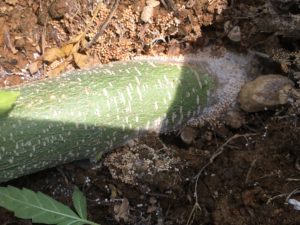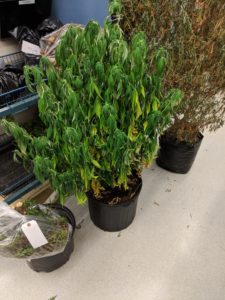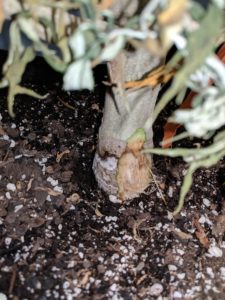Root Diseases Prevalent in Industrial Hemp
go.ncsu.edu/readext?615382
en Español / em Português
El inglés es el idioma de control de esta página. En la medida en que haya algún conflicto entre la traducción al inglés y la traducción, el inglés prevalece.
Al hacer clic en el enlace de traducción se activa un servicio de traducción gratuito para convertir la página al español. Al igual que con cualquier traducción por Internet, la conversión no es sensible al contexto y puede que no traduzca el texto en su significado original. NC State Extension no garantiza la exactitud del texto traducido. Por favor, tenga en cuenta que algunas aplicaciones y/o servicios pueden no funcionar como se espera cuando se traducen.
Português
Inglês é o idioma de controle desta página. Na medida que haja algum conflito entre o texto original em Inglês e a tradução, o Inglês prevalece.
Ao clicar no link de tradução, um serviço gratuito de tradução será ativado para converter a página para o Português. Como em qualquer tradução pela internet, a conversão não é sensivel ao contexto e pode não ocorrer a tradução para o significado orginal. O serviço de Extensão da Carolina do Norte (NC State Extension) não garante a exatidão do texto traduzido. Por favor, observe que algumas funções ou serviços podem não funcionar como esperado após a tradução.
English
English is the controlling language of this page. To the extent there is any conflict between the English text and the translation, English controls.
Clicking on the translation link activates a free translation service to convert the page to Spanish. As with any Internet translation, the conversion is not context-sensitive and may not translate the text to its original meaning. NC State Extension does not guarantee the accuracy of the translated text. Please note that some applications and/or services may not function as expected when translated.
Collapse ▲Root, Crown, and Stem Rot
Root, crown, and stem rots are being observed in industrial hemp stands across North Carolina. While several of these pathogens are opportunistic, many are severe problems that can have impacts on future crops. Currently, there are no chemical management tools available to producers that will economically reduce these pathogen pressures. Additionally, the use of chemistries off label may result in crop damage from potential phytotoxicity effects or crop rejection from buyers. This information is to serve as a guide to identifying problems and provide some cultural practices that may reduce impact by these pathogens.
Fusarium wilt and crown rot (Fusarium spp.)
Fusarium wilt and crown rot are caused by Fusarium spp. Damages associated with Fusarium wilt and crown rot include yellowing and wilting of leaves (Fig. 1) and vascular discoloration (Fig. 2). Root rots caused by Fusarium spp. are most often associated with other injuries to plant roots (i.e. environmental conditions, nematode injuries, mechanical injuries from cultivation). Plants that are over-irrigated or flooded from extreme weather conditions may be more prone to damages. Similarly, insect or nematode injuries may create wounds in the roots and crowns of plants that allow the fungus to colonize plants.
To reduce losses from Fusarium wilt or crown rot:
- Limit damages to roots by nematodes or root-feeding insects
- Avoid physical injuries to lower stems or roots of plants with farming equipment
- Remove affected plants from fields and destroy crop debris quickly after harvest to limit inoculum buildup
Southern Blight (Sclerotium rolfsii)
Southern blight/Southern Stem Rot is caused by Sclerotium rolfsii, which has a wide host range including vegetable, fruit, ornamental, field crops, as well as many weed species that may persist in the field. This disease causes the leaves to yellow and wilt, and the lower stem shows signs of necrosis (Fig. 3). In heavily infested plants, small, brown BB-shaped sclerotia (overwintering structures) can be found on white fungal mats at the base of stems (Fig. 3). This disease is favored by hot, humid conditions, which have been persistent this growing season.
To reduce losses from Southern Blight:
- Limit damages to roots by nematodes or root-feeding insects
- Avoid physical injuries to lower stems or roots of plants with farming equipment
- Remove affected plants and any fungal structures that are surrounding the plants from fields and destroy crop debris quickly after harvest to limit inoculum buildup

Figure 3. Industrial hemp crown affected by Sclerotium rolfsii. Photo courtesy of Eli Snyder, Extension Agent in Caldwell County
Pythium Root Rot (Pythium spp.)
Root rots caused by Pythium spp. are common in conditions with excess moisture or with a history of Pythium root rot. This fungal-like organism has spores that can move in water. Excess water surrounding hemp root systems make them more susceptible to disease, and the water allows pathogens like Pythium spp. to access the roots more easily. This can be found in greenhouse and field production systems, and can cause significant damage to plants. Plants yellow and wilt, and the roots become brown and necrotic. For more information on Pythium root rot, see the Pythium Root and Crown Rot of Industrial Hemp Fact Sheet.
To reduce losses from Pythium Root Rot:
- Limit damages to roots by nematodes or root-feeding insects
- Avoid excess water around roots and avoid watering from ponds, lakes, or streams as they can be a source for this pathogen
- Remove affected plants from fields and destroy crop debris quickly after harvest to limit inoculum buildup
For specific questions regarding industrial hemp disease management, contact your local N.C. Cooperative Extension agent.




